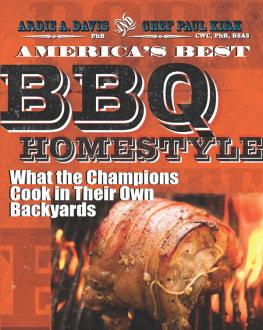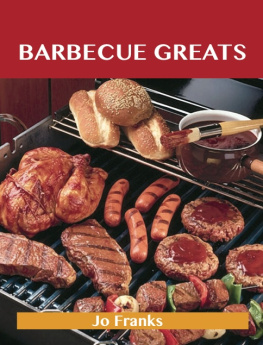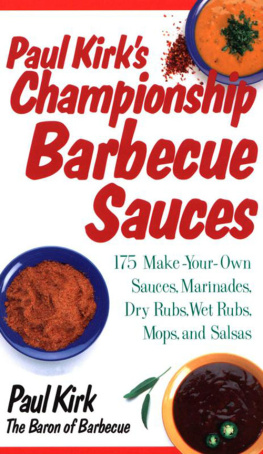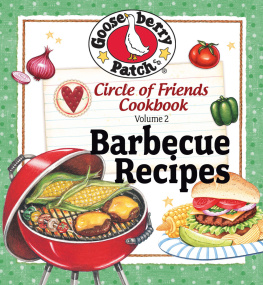AMERICAS BEST BBQHOMESTYLE copyright 2013 by Ardie A. Davis and Paul Kirk. All rights reserved. No part of this book may be used or reproduced in any manner whatsoever without written permission except in the case of reprints in the context of reviews.
Andrews McMeel Publishing, LLC
an Andrews McMeel Universal company
1130 Walnut Street, Kansas City, Missouri 64106
www.andrewsmcmeel.com
ISBN: 978-1-4494-3416-8
Library of Congress Control Number: 2012950109
Book design by Diane Marsh
ATTENTION: SCHOOLS AND BUSINESSES
Andrews McMeel books are available at quantity discounts with bulk purchase for educational, business, or sales promotional use. For information, please e-mail the Andrews McMeel Publishing Special Sales Department:
Contents
Backyard Barbecue Basics
Chapter 1: Beginners can save a lot of time, energy, and money by listening to basic advice from the champs, and seasoned backyard veterans might also learn a tip or two. After a combined total of at least 100 years of barbecue experience between us, one thing we know for sure is that, like all else in life, you never know it alltheres always more to learn.
When we asked the champs for backyard barbecue tips, a few commonsense constants emerged, plus some new ideas. Well begin with the constants.
COMMONSENSE BACKYARD BARBECUE BASICS
Put everything in its place. This culinary basic, coined in French as mise en place , is obvious and essential. Sometimes you can get by with forgetting something easy to fix, like herbed butter to finish your steaks. Other times you could be in big-time trouble if you forget to purchase an essential ingredient, thereby throwing off your timing.
Orchestrate everything. Boy Scout founder Lord Baden-Powells motto, Be prepared, was meant to apply to all aspects of living a responsible life, and pros will tell you its also an essential culinary principle. Think ahead as to how you will orchestrate every detail of your backyard barbecue. Our will help.
Befriend your local butcher. Paul, Paul, it worked! exclaimed an excited graduate of Chef Pauls pitmaster class. I did the whole routine. Introduced myself to the butcher. Told him Im getting into barbecue and need his help. Took home some ribs he recommended, smoked em, brought him a sample, and asked him why he had recommended those particular slabs. He told me how to pick the best slabs and said, from now on, just let him know when Im going to barbecue and hell set aside his best slabs for me. The late Wild Man Barry Martin was on a roll. He won at Grain Valley and, with two other students, garnered fifteen other awards.
Log it. Keep notes on each dish you cook. If you make changes, keep track. When dishes turn out to be exceptionally good, youll be able to repeat them without any guesswork. When dishes are disappointing, check your notes for clues as to what went wrong or how to improve it the next time.
Gear, Gadgets, and Extras
On the circuit, the pros use a variety of cookers, from custom-made to commercially manufactured. Fifty-five-gallon drums made into cookers; cinder block pitsabove or below groundwith grates and steel plates for lids; brick pits with carousel grates; aquarium pits with glass walls; stainless-steel pits fueled with gas, wood, electricity, or wood pellets; and large steel custom-made pits are what weve seen most often.
The barbecue industry is booming, with many companies offering grills that range from inexpensive to very expensive, but you dont need fancy or expensive equipment to cook like a pro. In fact, we know a backyard barbecuer in the Missouri Ozarks who gets by perfectly with a home-built pit made of cinder blocks, fencing, and an inverted steel wheelbarrow hood. Its not for everyone, but itll do. If you dont already have a grill, we recommend starting with the low-tech and inexpensive icon of backyard cooking, the kettle grill. As competition barbecuer Donny Teel of Buffalos Bar-B-Q tells us, One of my favorite pieces of equipment is a 22-inch Weber grill. You can buy one for $100 or less, and it works great for direct or indirect heat.
Its a good idea to think about and write down your barbecue lifestyle before choosing the best grill for your needs and your backyard. How often do you cook outdoors? What do you like to cook? How many people do you generally cook for? How much are you willing to spend, or does price matter? Knowing yourself, your wants, and your needs will lead you to making the best selection, and you may want to take your list of needs to a specialty barbecue store if youre buying your first grill.
Pauls standard advice is to figure out how and how many you are cooking for and get the cooker thats the next size up. The reason: you will get so hooked on how great your barbecue is that you will be throwing bigger parties. Its much cheaper to get the next size up than to buy two pits.
Finally, as Kelly and Roni Wertz of 4 Legs Up BBQ remind us, Know your cooker. If you are getting a new smoker or grill for the big party, get it a few weeks or a month ahead of time. Practice those dishes on your new cooker so you will know what temperature they need to run at to make everything work in your time frame. Or, as Clint Cantwell of Smoke in Da Eye puts it, Be one with the grill. The more you use it, the more comfortable youll be trying items other than hamburgers and hot dogs on the grill. By knowing its hot spots, how temperatures react when you open and close the lid, and other nuances, youll be cooking up grilled pizzas and rack of lamb in no time. And by all means, make sure to invite us over!
Charcoal Grills
The recipes in this book are from professionals, and they almost always use charcoal grills instead of gas, but you can use what you have and what youre comfortable with. The results may not be exactly the same, but youll still end up with some great barbecue. Whatever you use, study the owners manual for basic guidance and tips.
Charcoal grills are more affordable than gas grills, and they can reach higher temperatures. A charcoal grate holds coals on the bottom, and a grill rack above the coals holds the food. Vents on the bottom and in the lid help control temperature (on most models).
When cooking on a gas grill, bring depth of flavor by wrapping a handful of wood chips in a double layer of heavy-duty aluminum foil, poking a few holes in the foil, and placing the packet under the grates. The chips will slowly smolder, releasing flavorful smoke from this inexpensive smoke bomb while ensuring a quick cleanup.
Clint Cantwell, Smoke in Da Eye
Charcoal grills are pretty easy to maintain. Keep the grill rack clean, and after the grill cools, remove the ashes to ensure proper air flow the next time you grill. When the grill is completely cool, wipe the inside and outside surfaces of the grill with a soft cloth and warm, soapy water. Rinse with clean water and wipe dry. To help protect the body from the weather and minimize white spots and oxidation, use a paper towel to apply a light coating of vegetable oil to the outside of the grill while its cool. You can also buy a water-resistant cover to protect your grill when not in use.












